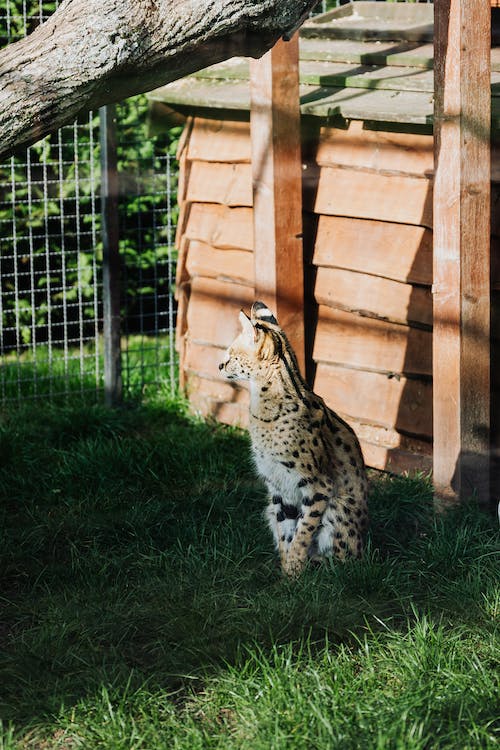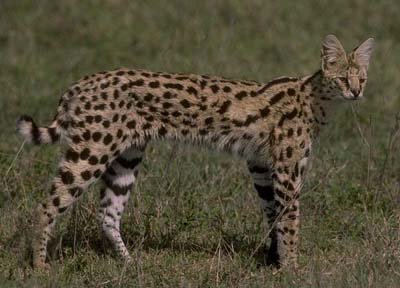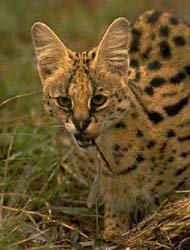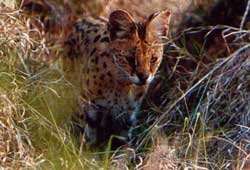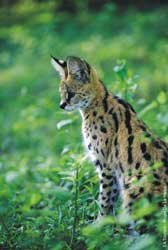SIZE: Shoulder height 60 cm, mass (m) 12 kg, (f) 10 kg.
COLOUR: Pale gold to tawny, with solid black spots which run in bands from back of neck to flanks. Black rings around short tail, back of ears, with two black bands separated by a white patch.
MOST LIKE: The Cheetah, which has a similar spotted coat, but is bigger with a much bigger head, a longer tail and smaller ears which are held back. The serval's ears are proportionately larger and held upright.
HABITAT: Open plains, savanna and woodland. Uses reed beds, long grass and bush for cover.
In addition to hunting its own prey, the Serval has constantly to be alert to danger in the form of carnivores bigger than itself. Spotted Hyenas are a major threat, and Leopards have been recorded to catch and feed on Serval in various parts of the continent. Nile Crocodile and African Rock Python pose a further threat to adults, while the young are most at risk to Martial Eagle and other large birds of prey.
Its diet consists chiefly of rats, mice and game birds, but it will also eat insects, especially beetles. If its prey is too large to eat in one sitting, then it will return one or two nights later to finish its course. This animal has long legs and is able to carry itself in speed for short distances. The serval is usually a nocturnal animal but can be seen in the early morning or evening. It prefers to use paths or roads, rather than to make its way across rough terrain.
The serval can catch a bird in flight with a leap into the air, and nothing will stop it when trying to catch a rat or any other rodent: it will even leap into water. It has very good hearing, and will silently and carefully track prey and kill it with a pounce on its two front paws.
If the serval is not really hungry, then he will tend to play with his prey before eating it. Although the Serval is considerably smaller in size than the Cheetah, it has similar proportions to the Cheetah and is easily mistaken for its larger relative when seen briefly or from a distance. Like the Cheetah, the Serval has long limbs but these are not used for speed - they allow the cat to leap nimbly and provide a vantage point to see above the vegetation. This long-legged cat has a small head and comparatively large ears (broad at the base with rounded tips) and a relatively shortish tail banded with black. It is marked with dark spots and blotches on a tawny background, which become elongated on the back to form stripes.
The Serval favours areas of tall grass, often close to water, in savannah and montane grasslands. It is most often encountered on the fringes of wetlands and riverine forest where food and cover is plentiful. Rodents - such as Mice, Voles and Cane Rats - make up the bulk of the Serval's diet, but small and medium-sized birds are regularly preyed upon. The cat's huge disc-like ears are used to detect the sound of movement, including that of rodents burrowing beneath the soil. Prey is typically stalked and then pounced upon in a leap, but birds are frequently plucked out of the air when taking off. Unlike many other cats, Serval are not shy to enter water, and readily pursue Ducks, Crakes and other waterfowl. Frogs, reptiles and even fish are captured and eaten whenever the opportunity arises.
They are normally solitary, but mating pairs move and hunt together, and females accompanied by juveniles up to 3 kg have been recorded, suggesting that the female and her offspring remain together for some time. Adult males and females occupy distinct territories which they patrol and scent-mark. Territories are frequently utilised - at least in part - by other individuals, and range in size from two to seven square kilometres, depending upon habitat and prey availability. There is no evidence to suggest that males occupy larger territories than females, as is the case with bigger cats such as Leopards and Lions.
Females have a gestation period of between 65 and 75 days, and usually give birth to two or three young (litters may number up to five). In their first weeks of life, the kittens are kept hidden in reeds, sedges or other dense vegetation and are frequently moved to avoid detection. The mother Serval must provision her family with a regular supply of meals, sometimes travelling considerable distances during both day and night, in search of prey. As the kittens develop, they become ever more inquisitive and it becomes difficult for the female to keep them hidden while she is out on the prowl.
WILDLIFE PARKS AND RESERVES WHERE THIS SPECIES IS FOUND:

